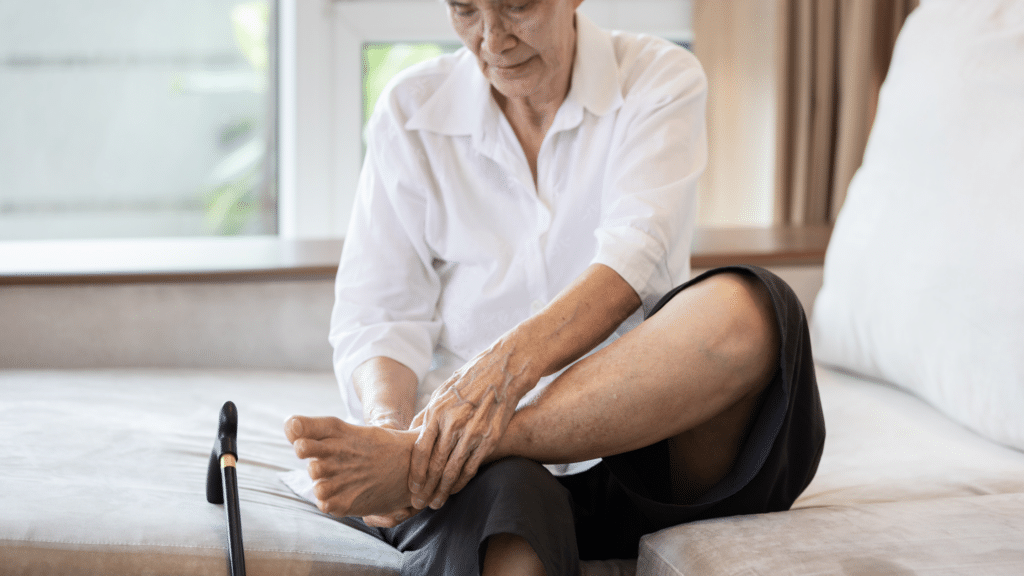Foot and ankle pain can severely affect day-to-day life. Whether it’s something as minor as a stubbed toe or a persistent condition like plantar fasciitis, nobody wants to suffer from foot or ankle pain. Pain in these lower extremities can differ based on where the pain is being experienced.
Types of Foot and Ankle Pain
Pain in Heel of Foot
Let’s start with pain in the heel. Plantar fasciitis is one of the most common causes of heel pain. This inflammatory condition affects the plantar fascia, the thick band of tissue that connects the heel bone to the toes. The stabbing pain associated with this condition is usually worse in the mornings. Plantar fasciitis is commonly seen in runners, individuals who are overweight, or as a result of poor arch supports in shoes. Continuous rest, ice, and stretching can help patients heal typically within a few months. Other treatments can include physical therapy, steroid injections, and proper orthotics to help distribute pressure more evenly across the foot.
Pain in Ball of Foot
Pain in the ball of the foot can have several different causes. Metatarsalgia is another form of inflammation that resides in between the arches and toes of the foot. Anyone is susceptible to this, however, it is commonly seen in runners or individuals with high arches. High arches put additional pressure on the toes and the heel. Poor-fitting shoes and frequently wearing high heels can also cause this type of inflammation. Those with metatarsalgia may experience tingling of the toes, pain in the ball of the foot, or the feeling of having a rock stuck in your shoe. Doctors may recommend using a metatarsal pad or shoe insert to help alleviate the pain. It is also recommended to avoid walking barefoot and to wear supportive shoes with a wide toe and low heel.
Morton’s Neuroma is a condition that affects the nerves around the base of the toes. The tissue surrounding the nerves of the toes, particularly the third and fourth toes, begins to thicken causing pain and numbness in the ball of the foot. This condition is a leading cause of disability. Patients are encouraged to wear shoe inserts to reduce the pressure put on the affected nerves. Over-the-counter pain relievers such as acetaminophen and ibuprofen can help lower inflammation and relieve pain at home. Additional therapies may include a steroid injection administered directly into the foot. These injections with steroids such as prednisone are a fast-acting way to reduce inflammation and help alleviate pain. Ultrasound-guided radiofrequency ablation, or RFA, has also proved to be an effective treatment. In this outpatient procedure, a radiologist or physician will use local anesthetic to perform RFA. Radio waves are able to produce an electrical current that heats up an area of nerve tissue and curbs pain signals. RFA has been a successful form of treatment in over 85% of Morton’s Neuroma cases.
Pain in Toes
Pain in the toes is common typically as a result of bunions, calluses, gout, and ingrown toenails. The treatment for all of these is similar. Wearing comfortable, supportive shoes is always important. Soaking feet in warm water may help alleviate pain. Use a pumice stone to remove calluses and rest the foot if necessary.
Pain in Ankles
Pain in the ankles that stems from an injury, such as a sprain or break, will reside as the injury heals. It is recommended to rest the ankle, elevate, apply ice to reduce swelling, and take an anti-inflammatory such as ibuprofen or acetaminophen.
Rheumatoid arthritis (RA) is a condition where the immune system begins to fight the body by mistake. RA typically affects the joints on either side of the body. For example, if you have RA in the left ankle, you will likely have it in the right ankle as well. Pain, swelling, and stiffness are all symptoms of RA. There is also a direct correlation between obesity and RA in lower extremity joints like the ankles and feet. Treating RA early can help speed up the healing process and some patients are able to achieve remission. RA can be treated with both NSAIDs and corticosteroids. NSAIDs are over-the-counter pain relief medications while corticosteroids such as prednisone require a prescription. Corticosteroids can be given orally or via an injection at the site of pain. Either form is effective in reducing inflammation and slowing the progression of joint damage.
Tendinitis is another cause of ankle pain. The Achilles tendon connects the calf muscles to the heel. Strains on this tendon can cause tiny tears leading to inflammation, tenderness, and discomfort. Swelling can reside in the back of the ankle and that area may be warm to the touch. Non-prescription pain-relieving medications can help manage the symptoms, but rest is the quickest way to heal.
The specialists at AOA Ortho are skilled in treating foot and ankle pain conditions. Fill out the form below to get in touch with our team.

